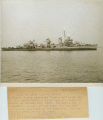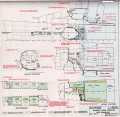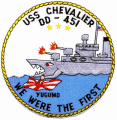Click On Image
For Full Size Image |
Size |
Image Description |
Contributed
By |
Namesake
|

| 46k | Born in Providence, R.I., 7 March 1889, Godfrey DeCourcelles Chevalier graduated from the Naval Academy in June 1910. He was appointed a Naval Air Pilot 7 November 1915 and a Naval Aviator 7 November 1918. In 1916 he participated in the installation of the first real catapult used in the Navy and piloted the first plane to be launched by catapult, from North Carolina. In November 1917 he commanded the first naval air station in France, at Dunkerque and for World War I service was awarded the Distinguished Service Medal. In 1922 he was attached to Langley, in connection with fitting her out. On 26 October 1922 Lieutenant Commander Chevalier flew plane No. 606 which made the first landing on Langley's deck. This distinguished pioneer of naval aviation died at the Norfolk Naval Hospital 14 November 1922 as a result of injuries sustained in an airplane crash. Digital ID: ggbain 28447, Library of Congress Prints and Photographs Division. | Bill Gonyo |
USS Chevalier (DD-451)
|

| 86k | Undated, USS Chevalier (DD-451) and USS Taylor (DD-468) underway in Pacific waters. Photo and text from "United States Destroyer Operations in World War II" by Theodore Roscoe. | Robert Hurst |

| 70k | USS Chevalier is refueled by USS Chicopee in convoy GUF2 returning from Africa between 29 November and 11 December 1942. The two midship 20mm, two vertical floats under the bridge platform, and 36 inch lights on the aft funnel are uniquely configured to Chevalier for Chicopee's convoy. | John Chiquoine |

| 86k | USS O'Bannon (DD-450) picking up a pilot while operating with Task Force 36.1 in the Solomon Islands area, circa 3-4 July 1943. USS Chevalier (DD-451) is seen beyond O'Bannon's stern. Courtesy of Rick E. Davis, 2012. Source: United States National Archives, Photo No. 80-G-259193. | Mike Green |

| 145k | Shortly after midnight on 5 July 1943 the crew of USS STRONG (DD-467) would forever be grateful to the crew of USS CHEVALIER (DD-451). That night in opening actions for what became known as the Battle of Kula Gulf, USS STRONG was torpedoed by a IJN destroyer. She was nearly cut in half. CHEVALIER almost immediately came to her assistance by ramming her bow in a glancing angle into STRONG's portside at 0100. CHEVALIER was still under fire and was continuing to fire back at the enemy and in the action experienced a hang-fire in 53 mount. During the next 23 minutes CHEVALIER's crew took off 232 enlisted and 7 officers from STRONG. Casting off the rapidly sinking STRONG at 0123, CHEVALIER was shaken by STRONG's exploding depth charges. At 0125 the hang-fire exploded with only one injury from the explosion and fire.
USS CHEVALIER returned to Tulagi harbor at 1041 with the rest of TF 36.1. After off loading the survivors and making minor repairs she then continued on to Espiritu Santo the following day for repairs to her 53 mount and bow lasting until 22 July. CHEVALIER went on to serve in the South Pacific until she herself was lost on 6 October 1943 to a IJN torpedo. In a final act as she was sinking, CHEVALIER fired her torpedoes into a crippled IJN destroyer.
Until the discovery of this image of USS CHEVALIER during her service in the South Pacific there were no good views of her after October 1942. Even though the destroyers in DesRon 21 were among some of the most photographed destroyers, clear photos of CHEVALIER were not among them. This photo was found last summer, quite by accident among a series of photos taken during the Kula Gulf events including this remarkable photo of CHEVALIER tied up at the Government Wharf in Tulagi harbor on 6 July 1943, taken from USS NICHOLAS (DD-449) as she returned from the Battle of Kula Gulf. Official USN Photo 80-G-259220 residing at NARA and NH107950. | Rick E. Davis |

| 89k | Destroyer Squadron Twenty-One. Three of the squadron's ships underway in the Solomon Islands, 15 August 1943. The ships are (from front to rear): USS O'Bannon (DD-450), USS Chevalier (DD-451) and USS Taylor (DD-468). Photographed from USS Nicholas (DD-449), while the ships were enroute to the landings at Vella Lavella, which took place on the same day. Official U.S. Navy Photograph, now in the collections of the National Archives. | Fred Weiss |

| 106k | Destroyer Squadron Twenty-One. Three of the squadron's ships steaming in column, while en route to Guadalcanal and Tulagi on 15 August 1943, following the Vella Lavella landings. Photographed from USS Nicholas (DD-449). The ships seen are(from right to left): USS O'Bannon (DD-450), USS Chevalier (DD-451) and USS Taylor (DD-468). Official U.S. Navy Photograph, now in the collections of the National Archives. | Fred Weiss |

| 75k | The United States Destroyer "Chevalier" which was lost in a South Pacific action during a night engagement on October 6th, 1943. The Chevalier was severely damaged by the enemy and collided with another Destroyer in the formation. She subsequently broke in two and sank. U.S. Navy Official Photo from ACME. Photo from the MacArthur Museum of Arkansas Military History. | Joe Radigan/Robert Hurst/Bill Gonyo/Scott Dyben |

| 300k | United States Naval Department Bureau of Ships War Torpedo Damage Diagram and Report No. 50. USS Chevalier (DD-451). Destroyer torpedo and ramming damage and loss on October 6, 1943 at Vella La Vella. | Mike Green |

| 175k | Ship's patch. | Don McGrogan |

| 100k-120k | Uniform Ship's name shoulder patch. | Al Grazevich |


 54 of her crew were lost with the ship and remain on duty.
54 of her crew were lost with the ship and remain on duty.
